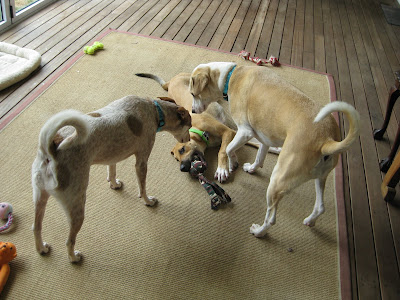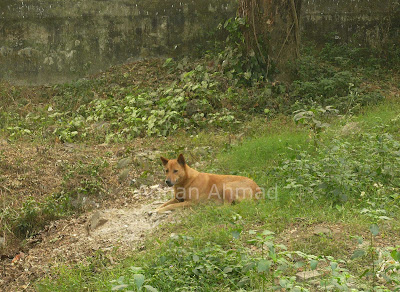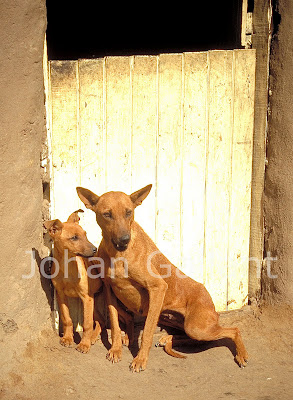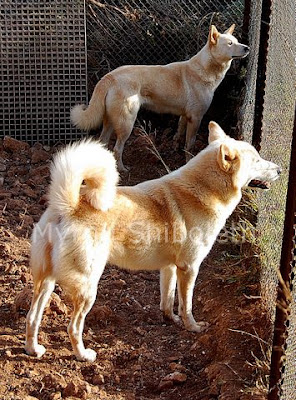This is about the origin of the urban free-ranging dog, commonly (and questionably) called the "stray." It's my effort to fill in the blank of "where did urban street dogs come from in the first place?"
Though this is not an animal welfare site, I've come across some strange theories about street dogs here and there and want to put across my opinion too.
Mine is based on my reading about free-ranging dogs, aboriginal dogs, dog evolution, and also on my personal experiences and observations of nearly two decades of dog-watching.
I believe that to understand how free-ranging dogs came into being, we have to first understand how dogs came into being. Please don't skip this bit, it's important.
I agree with the theory, brilliantly put forward by the biologists Raymond and Lorna Coppinger, that dogs are NOT the result of intentional domestication by humans: rather they are self-domesticated, like the domestic cat. In a nutshell, when humans started living in settlements, the garbage they created (bones and other edible waste) would have attracted wild carnivores as an easily obtainable source of food. Some species of wild canid, possibly the wolf or some other canid now extinct, took to scavenging rather than hunting as an easy means of survival.
Over generations this canid changed physically until it had perfectly adapted to its new ecological niche: scavenger around humans. It had evolved into what the Coppingers call the Village Dog: a domestic dog of generalized appearance, habituated to proximity to and dependence on humans, in other words no longer wild.
The Coppingers point out that this type of dog is still to be found in some parts of the world today. Never intentionally "bred" or tampered with by humans, but a product of natural selection alone. What PADS and other experts/enthusiasts call the primitive or aboriginal dog.
To many (including me), this is a much more acceptable explanation of dog domestication than the conventional theory we were brought up to believe - that Neolithic Man went forth and captured and domesticated the Wolf, and by some mysterious technique created the Dog. It is much more likely that the dog created itself, and only AFTER that had happened, Man started picking up pups and much much later, selectively breeding them for specific functions. Hunting, guarding livestock, guarding property.
Only in the last 200 years have dogs been bred for their looks and for winning prizes in the show ring. Almost all the "pure" breeds (as we call them) were developed only in the last two centuries.
So what has all this to do with India's free-ranging dogs and the much discussed "stray dog" issue?
Some Indians seem to believe that our street dog population has been created by a large-scale ongoing abandonment of pets. This is a perfect example of how facts and ideas from Europe/USA are unquestioningly accepted and mechanically applied to Asia, without any thought or research into dog populations here. Yes, most feral dog populations in Europe and the USA are descended from abandoned dogs of many breeds. But here?
Zooarchaeology and ancient literature show us that India has had free-ranging scavenging dogs since the earliest times. Such dogs are mentioned in the Panchatantra and the Mahabharata and elsewhere (read Sanskrit scholar Willem Bollee's interesting compilation mentioned below). Was there really such a mindbogglingly large-scale abandonment of pets over 2500 years ago as to result in such flourishing street dog populations? Slightly hard to believe. Where did all those pets come from anyway?
Here's the more realistic explanation for the existence of urban street dogs. Village dogs in the free-ranging scavenger niche have existed for thousands of years, at least 15000 years if not earlier. Many are pet dogs, as anyone who spends time in rural India will have noticed. But they roam unsupervised and also scavenge like ownerless dogs, and to people unfamiliar with village life they would seem like "strays."
As urbanization takes over rural areas, these village dogs become city street dogs. If you've watched Navi Mumbai develop and grow you will have seen this happening, that is if you pay attention to dogs of course. I can see the same process taking place in the small town Alibag as it grows and spreads into the surrounding countryside. It's happened for centuries around the country and it's happening now.
Garbage is much more abundant in cities thanks to the density of human population - and that directly leads to increased numbers of dogs, until the carrying capacity of the neighbourhood has been reached. Although primitive and aboriginal dogs breed only once a year and infant mortality is high, enough pups survive to fill territorial niches vacated by death and dispersal of adult dogs.
Abandoned pets must be adding to this population, but common sense and observation should tell us that they are not the main source. For one thing pet ownership itself is not as common in urban India as in developed countries. An example: only three families in our building own dogs (out of 124 apartment owners), and in the 20 odd flats in the remaining three buildings of our society, only three families own dogs. I'd say this is the pattern in most residential buildings in Mumbai or Kolkata (the other city I know well). This is not comparable to the 39 per cent of people estimated to keep dogs in the US (click here for the source of this figure).
Also compare the type of dogs kept as pets to the ones you see living on the road. If all of us in our housing society were to abandon our pets suddenly, that would put two pekingese, a french poodle, a labrador, a dachshund, a lhasa apso, a boxer and three neutered INDogs on the mean streets of Mumbai. Guess how many would survive let alone breed? Also, does the street dog population really consist of labradors, german shepherds, pugs, boxers, pekingese and the like? Granted our urban dog population is mongrelized and certainly not pure indigenous dog, but neither are they all solely of "pedigreed" dog descent.
And that's enough from me for now. All other aspects of the "stray dog issue" have been written about at length elsewhere and do not really belong in this blog.
Further reading:
- Those interested in this topic should read the glossary in the INDog site.
- Also read the articles in the "Links" section of the site, specially those by Dr Sunil K Pal who has researched the behaviour of free-ranging dogs for many years.
- Raymond and Lorna Coppinger's "Dogs: A Startling New Understanding of Canine Origin, Behaviour & Evolution" is widely acclaimed and one of the most interesting books I've ever read.
- Stephen Budiansky's "The Truth About Dogs."
- Professor Willem Bollee's Indological study "Gone To The Dogs In Ancient India."






































